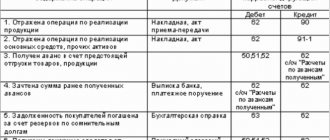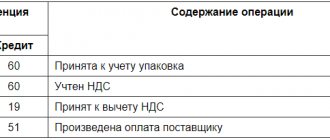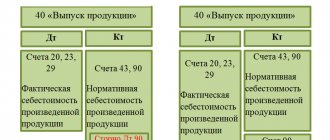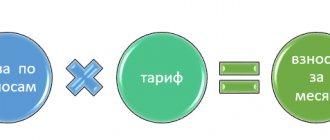How to compile them? Basic principles
When conducting accounting, specialists will use three types of accounts: active, passive and active-passive . Active enterprises must reflect cash, inventory, fixed assets and non-current assets, inventory balances, etc. Passive legal entities reflect all their obligations to the state, business partners, employees, and creditors.
Active-passive accounts are also designed to display business transactions, but differ in that they can simultaneously contain both a credit and a debit balance. An example is the debt (prepayment) that a particular supplier has to a company in parallel with the debt (goods received without payment) that the same company has to the same supplier.
When preparing accounting entries, you need to remember the following nuances:
- active accounts can only have a debit balance, while passive accounts can only have a credit balance;
- the increase in passive accounts occurs only by credit, and active accounts - by debit;
- the balance on active-passive accounts can be reflected simultaneously in both liabilities and assets of the balance sheet;
- when compiling a balance sheet, the balances of passive accounts are displayed on the right side, and the balances of active accounts on the left;
- to reduce an active account, you need to make entries on its credit, and to reduce a passive account, you need to make debit entries.
Posting is a way of expressing the correspondence of accounts, the basis for which is a completed business transaction. When compiling them, it is recommended to adhere to the following scheme:
- It is necessary to determine which accounts and accounting objects are affected by the transaction being processed (its economic content is taken into account).
- It is necessary to establish which accounts will be involved in the posting (passive or active).
- The account to be credited or debited must be determined. To do this, the sources of origin of the operation and all related factors are taken into account.
When making simple entries, two accounts are affected, for example, when money is received at the company's cash desk from the current account, the following entry is made: Kt 51 Dt 50. When making complex entries, several accounting accounts are involved.
You can clearly see the procedure for making transactions in the following video:
Double entry principle
Reflection of business transactions on accounting accounts by specialists is carried out using the double entry method.
The essence of this method is as follows: for each operation, the accountant makes a corresponding entry simultaneously on the debit of one account and on the credit of another account .
Concept and types of services
Paid provision of services is an agreement between the customer and the contractor, according to which the contractor undertakes to perform the services specified in the contract, and the customer undertakes to pay for the services performed in accordance with the terms of the contract (Articles 779 and 781, Chapter 39, Part 2 of the Civil Code of the Russian Federation of January 26, 1996. N 14-FZ as amended on May 23, 2016).
Free provision of a service is the provision of a service to a counterparty without receiving payment from him (Article 423 of the Civil Code of the Russian Federation).
The contract for the provision of paid services may indicate, for example, the following services:
- Transport services (example 1);
- Accounting services (example 2);
- Courier services (example 3);
- Repair services (example 4);
- Advertising services, etc.
Posting examples
Currently, a large number of methodological manuals are regularly published for accountants, which indicate the most common entries for a particular type of activity.
Using existing examples, specialists will be able to avoid the most common mistakes when compiling correspondence accounts and posting them to the appropriate accounting registers.
By salary
When preparing entries for operations, the essence of which is to carry out settlements with employees, specialists must make the following account correspondence:
| Debit | Contents of a business transaction | Credit |
| 20, 23, 26, 92 | Salary accrued | 70 |
| 70 | Salary issued from cash register | 50 |
| 68 | Mandatory taxes charged | 70 |
| 51 | Escrow payment (unpaid) | 50 |
| 50 | Received money in the cash register to pay salaries | 51 |
Renting premises
When renting out space or a building, entries are made by both the owner of the fixed asset and the tenant. They prepare correspondence accounts for any action related to the leased property.
The main ones are shown in the table:
| Debit | Contents of a business transaction | Credit |
| 01 (sub-account “Assets leased out”) | Leased premises | 01 |
| 20 | Depreciation has been calculated on the transferred premises | 02 |
| 50, 51 | Rent received | 62 |
| 90 (sub-account 2) | Depreciation and other rental expenses written off | 20 |
| 001 | The tenant received the premises | |
| 76 | Rent transferred | 51 |
| 44, 29, 26, 25, 23, 20 | Rent arrears | 76 |
Wholesale and retail trade
When carrying out business activities related to the sale of goods, finished products, works or services, legal entities make many transactions.
To reflect transactions in this area in accounting, the following entries must be made:
| Debit | Contents of a business transaction | Credit |
| Money transferred: | ||
| 62 | refund of advance payment to buyers | 51, 50 |
| 61 | suppliers | 51, 50 |
| 45 | Products shipped to customers | 41/1 |
| 41/1,41/2 | Received goods from suppliers | 60 |
| VAT reflected | ||
| 19 | on goods received | 60 |
| 41/2 | in retail | 60 |
| 90/03 | by goods shipped | 68 |
| 90/03 | in retail | 68/02 |
| 62 | Implementation reflected | 90/01.1 |
| 92.R | retail | 90/01.1 |
| 91/02.1 | The cost of shipped products is reflected | 45 |
| 91/02.1 | in retail | 41/1 |
Assignment agreement
When drawing up this agreement, the accountant of any commercial organization carrying out economic activities in the status of a legal entity must draw up correspondence accounts.
For such operations the following transactions are used:
| Debit | Contents of a business transaction | Credit |
| 58 | The cost of all rights acquired by the company under the assignment agreement previously signed between the parties is reflected. | 76 |
| 76 | The debt that arises to the assignor is repaid in full or in part | 51, 50 |
| 50, 51 | The debt was received from the debtor to the current account or to the company's cash desk | 76 |
| 76 | The amount of all repaid debts is taken into account as part of income | 91/1 |
| 91/2 | Accounting for acquired rights of claim as expenses | 58 |
Cash transactions
Business entities must document cash transactions in accordance with the CCP in force on the territory of the Russian Federation.
To compile correspondence, the accountant uses the following accounts:
- 50 – cash register;
- 51 – current account;
- 70 – payroll calculations;
- 73 – other calculations;
- 62 – settlements with customers;
- 75 – replenishment of the authorized capital;
- 71 – settlements with accountable persons;
- 91 – reflection of exchange rate differences;
- 94 – reflection of shortages;
- 76 – other payments.
| Debit | Contents of a business transaction | Credit |
| 71 | Money issued to accountable persons | 50 |
| 50 | Unused imprest amounts were returned to the cash desk | 71 |
| 70 | Salary issued | 50 |
| 50 | Received money from current account | 51 |
| 50 | Buyers paid for the goods | 62 |
| 50 | The founders replenished the authorized capital | 75 |
| 94 | Shortage written off | 50 |
| 91 | Exchange rate differences reflected | 50 |
How inventory is accounted for at an enterprise - see this article. You can find all the necessary information about business transactions in accounting here.
Provision of services
When providing services, business entities draw up acceptance certificates. If a legal entity is a value added tax payer, it is obliged to issue an invoice according to which VAT is deducted.
The following entries are made in accounting:
| Debit | Contents of a business transaction | Credit |
| 26 | Service provided to the client (excluding VAT) | 76, 60 |
| 19 | VAT is reflected | 76, 60 |
| 50, 51 | Payment for services received | 60, 76 |
| 68 | VAT amount submitted for deduction | 19 |
| 90 | Expenses are written off to cost of sales | 26 |
With fixed assets
If a business entity has fixed assets on its balance sheet that it uses in carrying out business activities, it must draw up correspondence accounts as follows:
| Debit | Contents of a business transaction | Credit |
| 01 | Fixed assets received from suppliers were added to the balance sheet | 60 |
| 60 | Invoices paid | 51 |
| 07 | Related expenses reflected | 60, 76 |
| 07,19/1 | All taxes and fees reflected | 68 |
| 91/2 62 | Fixed assets sold | 01 91/1 |
| 51 | Funds transferred from buyer | 62 |
| 91/2 | VAT charged | 68 |
| 02 | Accrued depreciation written off | 01 |
Closing of the year
At the end of each reporting year, the accountant is required to make special entries that will allow some accounts to be closed. This procedure is called balance sheet reformation , it represents the zeroing of some accounting accounts.
It is mandatory for specialists to close accounts 90, 91, 99 and prepare the following correspondence:
| Debit | Contents of a business transaction | Credit |
| 90/9 90/1 | Account No. 90 is closed | 90/2, 90/4, 90/8 90/9 |
| 84 | Received loss | 99 |
| 99 | Profit received at the end of the year | 84 |
| 91/9 99 | Account No. 91 is closed | 91 91/9 |
Taxes and state duties
Each business entity, when conducting business, is faced with the need to accrue and transfer taxes, mandatory payments and fees to the budget. Also, legal entities have to pay a state fee when preparing documents or receiving any services from government agencies.
In accounting, they are required to reflect every business transaction related to taxes, fees and duties:
| Debit | Contents of a business transaction | Credit |
| 68 | Transfer of state duty | 51 |
| 99 | Profit tax calculation | 68 |
| 70 | Personal income tax withheld | 68 |
| 68 | Transfer of taxes to the budget | 51 |
| 91/2 | Transport tax charged | 68 |
| 90/3, 91/2 | VAT charged on sale | 68, 76 |
| 68 | VAT paid | 51 |
Loans issued
When accounting for loans, which have recently begun to be actively issued to both full-time employees and business partners, the following entries are made:
| Debit | Contents of a business transaction | Credit |
| 58 | Short-term or long-term loans are issued | 51 |
| 51 | Interest received on current account | 58 |
| 50 | Interest received at the company's cash desk | 58 |
| 58 | Interest accrued | 91 |
| 51 | Loan repayment is reflected in accounting | 58 |
Acquiring
In recent years, Russian companies have increasingly begun to use acquiring in their work, which allows them to accept bank cards from buyers (when paying for goods, works or services sold). When carrying out this type of calculation, accountants may encounter various problems that relate to the process of preparing entries.
Using standard invoice correspondence, they will be able to minimize the risk of making errors, which often cause penalties:
| Debit | Contents of a business transaction | Credit |
| 62 | Sales of goods | 90/1 |
| 90/3 | The amount of VAT is taken into account | 68/3 |
| 57 | Settlements with the buyer are closed (documents are transferred to the acquiring bank) | 62 |
| 57 | The revenue received from the buyer who paid for the goods with a payment card is reflected. | 90/1 |
| 51 | Received money from the acquiring bank | 57 |
| 91 | Related expenses written off | 57 |
| 96 | Purchase returns | 62 |
| 20/1 | The bank received an application from the buyer | 57 |
| 57 | Funds transferred | 51 |
| 57 | The commission charged by the bank is adjusted | 91 |
The principle of generating accounting entries
To create postings, know: there are active and passive accounts. Active accounts increase in debit and decrease in credit. Passive is the opposite. Active ones reflect the company's assets, and passive ones reflect its debts.
Let's look at the principle of generating postings using examples:
You purchased materials from Supplier LLC in the amount of 100,000 rubles. As a result of the operation, an asset increased - materials, and a liability - the debt to the supplier, since you have not yet paid the money. Based on the meaning of the operation, we understand that you need to use account 10 “Materials” and account 60 “Settlements with suppliers”. All that remains is to figure out what goes as a credit and what goes as a debit. Start with the count that makes most sense to you, which is probably 10 “Materials.” Account 10 is active, since it reflects property, and, therefore, it grows by debit. The amount of materials you have has increased, therefore, we are building wiring: Dt10 Kt60 in the amount of 100,000 rubles.
Important! Postings are always written in monetary terms!
Now you need to pay the debt to Supplier LLC. The score 60 reflects our debts, which means it is passive. Therefore, a decrease in debt is reflected in debit. We pay the debt from the accountant - account 51. The money on it is undoubtedly our property, it is reduced by the loan. We are building wiring: Dt60 Kt51 in the amount of 100,000 rubles - the debt to Supplier LLC has been paid.







